Start your game effectively and place your chess pieces on strong squares right from the start. If you are a beginner first read the basic chess rules and then come back here.
Chess Strategies for Beginners
Important! Make sure you learn Chess Notation to be able to read and write chess moves.
Don’t waste Time! When you start your Game, develop your Chess Pieces (Knights and Bishops) as quickly as possible and castle EARLY! Don’t make meaningless and unnecessary pawn moves.
If you waste time playing senseless pawn moves instead of developing pieces (Knights and Bishops), then you get a bad position and your chances of losing your game are increasing.
See below – White made senseless Pawn Moves and loses
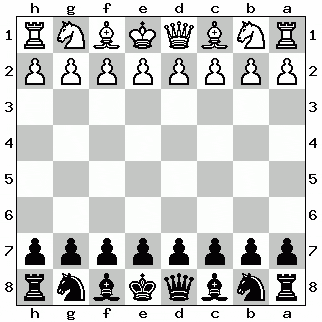
Most Common First Moves are 1.e4, 1.d4 and 1.c4
Avoid making inferior pawn moves. For example, never play the edge pawns in the beginning as they have no influence on the center squares and do not help to get your pieces (Knights and Bishops) out.
What is the best opening move in chess?
The Checkmate
Yes, you want to know how to checkmate the King. I will show you now a lot of interesting positions where the king is checkmated. Every piece can checkmate the king, a pawn as well.
I hope these chess positions will make something move under your hat. After all, you got to start somewhere, don’t you?
The Checkmate
To answer many of your chess questions it helps a lot when you Read the ANSWERS to QUESTIONS here!
Basic Endgames
I will show you first some fundamental endgames that you should know. When you reach the endgame you need some basic understanding about how the king moves, without getting confused by too many pieces on the board.
Please replay the selected endgame positions below and study them until you are able to handle those situations in a real game.
Basic Chess Endgames
Pawn and King Endgame explained
Play and make Draw in King vs Pawn Endgame
Play and win King versus Pawn Endgame
Important Practical Chess Lessons for Beginners
Chess Training – Give Checkmate with a Queen up! You must be able to give checkmate with a Queen. This is important. Try this exercise until you can do it.
Chess Training – Give Checkmate with a Rook up! You must be able to give checkmate with a Rook up. Try this until you can do it.
I hope you got the idea now and have seen what we are doing here and what is chess all about. Then go right away to the following lesson. This one will train your tactical eye. Solve some checkmate-in-one problems here. They are very easy. Hey! This is baby stuff so this should be like a snap for you.
Checkmate-in-1
Study Checkmate-in-1 Chess Positions
and come back after.
Now, did you have fun? Yes, that’s the way to go and here is the next beginners exercise.
Another Checkmate in 1 Lesson
Checkmate-in-2
Checkmate in 2 – Chess Positions
Easy Checkmate in 2 – Chess Lessons
Checkmate Patterns you should know
Get High Quality Chess Courses for BEGINNERS created by Chess Grandmaster Igor Smirnov
Bad Chess Strategy – What you should NEVER do!
Never move silly pawns anywhere in the beginning of the game, especially not on the outer files like Black has done below. You just lose time and run behind in piece development.
This means that your opponent can and will attack you with his pieces, once he has castled. Pieces are: knights, bishops, rooks and the queen, not pawns! He can attack you as he has more pieces developed than you have. He will simply overrun you in the center because he has more knights, bishops, rooks and the queen actively placed and you got no pieces placed actively to defend yourself. Why? Because you have wasted your time to push some silly pawns here and there and may have not even castled.
It is very important that you understand this principle!
Read this text above a hundred times to get this into your head or you will never ever become a good player. So don’t touch useless pawns in the beginning of the game.
You should first move one or two center pawns, then develop your knights and bishops towards the center. Best is to get the kingside knight and bishop out, then castle quickly. See the white position. White is going to get out his kingside bishop next and castle afterwards.
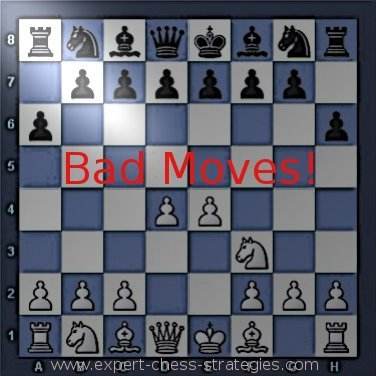
How to start a game
The next lesson shows you how to start a game of chess and I will explain every move in the opening for you.
How to start a Game – Chess for Dummies
Don’t play like that! – Learn Chess Online
Silly Chess Moves
The Pin
And now you can study an important element of chess tactics. The Pin. This will show you how beautiful chess is.
The Pin – Easy Chess
Decline Draw Offers
Decline Draw Offers – Chess Tip
Get some good chess books.
“When you are lonely, when you feel yourself an alien in the world, play Chess. This will raise your spirits and be your counselor in war.”
Aristotle
Chess Formation Strategy
I show you now how to start your game. Before you start to play you should know where to place your pieces – know the right chess formation strategy.
Where do you place your pawns, knights and bishops, when do you castle and what happens to the queen and the rooks. When should you attack? Or do you have to attack at all? Questions over questions.
I will give you a rough idea now. Please study the following chess strategies for beginners carefully.
Read the Guidelines:
Chess Formation Strategy.
Chess Courses for Beginners! Read more …
ASK QUESTIONS HERE – but read the Answers already given, before you ask!
Black develops queen too early and gets overrun
Chess Thinking
Now try to get mentally into the real game and try to understand some of the following positions. Some are difficult to master, but don’t worry, just repeat them the next day to get used to chess thinking. Your brain has to adjust, that’s all there is to it.
Win some Positions here! – Chess Puzzles
Did you manage it all right? It is necessary that you understand the following basic chess strategies for beginners called – Endgames or Endings, using the heavy pieces.(queen and rook are called heavy pieces)
Check them out now!
Rook and Queen Endgames – Basic Chess Strategies
How a Beginner plays Chess
Replay the games of a beginner.
Beginner Chess – Games I
Chess for Beginners – Games II
It was hard, wasn’t it? Yes, chess is a hard game. You got to have discipline, yep! Chess teaches…It is hard to start a game and make the right moves all the time. This is almost impossible, I know.
What do you think before you make a move? Try to understand the following chess strategies that are applied. In the following games Black needs to learn some chess strategies for beginners because he plays like a beginner. See next lesson.
How to play a Chess Game and exploit Mistakes – Beginners Chess
How did you go? Did it make click under your hat? Yes, it’s mind blowing in the beginning, I know. When I learned chess I dreamed about chess positions at night. I have got some more training here now.
How to win with Checkmate in 2
I got here a mixed cocktail of training positions.
Mixed Chess Positions – Basic Chess Strategy
In the Beginning you lose all Games! So what!
In the beginning when you start playing chess you are going to lose all games. So? Come back here and study more openings and more chess strategies for beginners. And one day you get them!
I tell you a secret. When I entered a chess club as a beginner, I was losing, losing and losing for the next few months to come. Because nobody had told me any chess strategies for beginners.
It is quite normal that you lose in the beginning as most players got years of practical experience and knowledge. So how can you match that? You can’t, my friend! You must lose at first. That’s the way it is!

How to handle special Situations? – Chess Strategies for Beginners
Defend it! – How to play a Chess Game
And when things are getting really tough and you are losing then you might discover a perpetual check and you can force the same position three times in a row and more…which gives you a draw.
Force a Chess Draw with Perpetual Check!
And because you liked it so much there is just the next chess strategies for beginners lesson waiting for you here.
Force a Draw somehow – Basic Chess Strategies
You are warmed up now. Try to find a winning move!
Find the Winning Move – Good Moves
It is getting harder now!
Find it! – Learn to play Chess
Avoid Unnatural Moves and put your pieces on proper squares!
Unnatural Moves – Learn Chess Strategies
Play the following position to the end and learn how to win this endgame as White.
Win this Endgame as White
In the lesson below you are up in material and should win.
Play this Chess Position and win versus the Chess Program
You are up in material and have a strong winning advantage below.
Win this Chess Position versus the Chess Program
Chess Openings – Chess Strategies for Beginners
Yes, my friend we get there. We come to the chess openings now. This is great fun. When you know an opening well, you don’t even have to think for the first twelve moves or more. You just play the moves within a few minutes. And if your opponent has no idea, how to open the right way, you just run him over in no time at all…
How do I start my game? What is the right plan?
Good chess openings will guide you and bring you on the right path.
I tell you something, a lot of games are lost already before they even started, right in the chess opening. Many beginning players just don’t have a clue how to start a chess game properly and they get overrun by stronger players right from the start. They have not the slightest chance to get the pieces out properly or they put the pieces on wrong squares or run early into a devastating attack or, or, or….
Example: Don’t move the pawn on f7 beside your king! Or you lose the exchange – rook for a knight! See the following game. And don’t move this pawn in similar situations as this is equally bad.
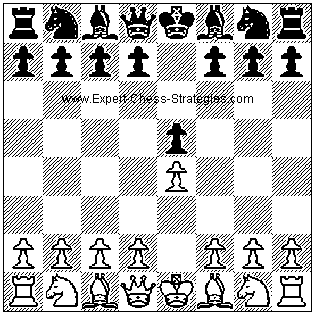
1. Your first move should be e4. (or d4)
(or c4, maybe later in your personal development phase).
To learn the principles of chess, it is important that you play open games with a lot of active play and combinations. This is best achieved by playing only e4 for many months to come. This is the most popular opening move. Bobby Fischer said about this move: Best by test! He himself played it nearly always.
2. Don’t play closed positional chess openings in the beginning of your chess career!
If you would always start with e4 in every game you play, you have still a lot to learn which can take up a lifetime, believe me. You could specialize on e4 in your entire chess career and play nothing else with the white pieces.
Many grandmasters play positional chess openings starting with d4,c4 or Nf3. But you are not ready for that.
Get some good chess books or get high quality chess teaching videos created by a chess grandmaster!
3. Play active! Get the initiative, if you can!
Learn to play open, active, tactical-rich games first, until you understand the chess principles. Those principles are best demonstrated in games opened with the move e4! Later on you can learn chess openings. But this is not necessary at first.
Just play wild chess games so much as you can. That way you get used to the way of thinking in chess and learn how the pieces move about.
4. Develop first your kingside pieces and castle and don’t attack right away if black plays good developing moves.
Use common sense! It can’t be right to attack somebody who makes no mistakes and has developed all pieces correctly. If you do attack him, you will n o t develop your pieces fast enough and will lose center control and sooner or later the game! Always develop your pieces f a s t and don’t move any useless pawns unless the pawn move is a center-pawn-move that controls vital center squares and is necessary for developing the pieces.
Find the right opening and study it!
I recommend that you study the Ruy Lopez ( Spanish Chess Opening Strategy ), Italian Game (Giuoco Piano) and the Sicilian Defence for a start.
If White plays 1.d4 and 2.c4 setup.
Then play the Cambridge-Springs Defense. Just try to learn the following moves now! This will be a good test for you in memorizing opening lines. This opening is easy to learn!
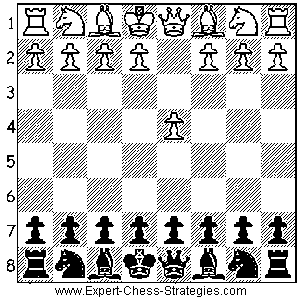
I will show you the games now. Go to Cambridge Springs Defense.
If White plays 1.d4 and 2.c3 setup – The Colle System.
Learn the right setup for Black. If you have White and like to play d4 from time to time yourself, just to get the feel for it, then I recommend the Colle System – Basic Chess Moves for you. This chess opening system is easy to learn.
It is important to know the Colle System when you have the black pieces, because sooner or later an opponent will play it against you. When you have Black and like to play the Cambridge-Springs, but your opponent does not play the pawn to c4, but to c3 instead (Colle-System), then what are you going to do then?
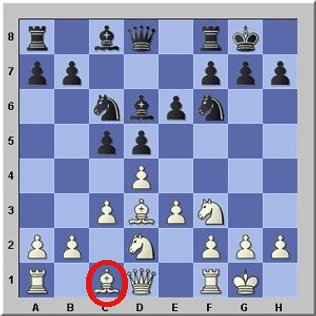
When you play the “Colle” as White, then you gain a good understanding of this opening and know how to handle it when you have to play against it with the black pieces.
The “Colle” is a good opening for beginners only, but not for advanced players as Black can easily equalize. Advanced “white” players play d4, c4 systems, not c3-systems, as c3 is too passive. Understand this: The c3-pawn occupies the natural square for the queenside knight, which should go to c3, where it is ideally placed. (Nc3!). But the knight can’t go there because the c-pawn is sitting there. Simple logic.
That’s why the knight must go to d2 instead (Nbd2), where it has reduced power and strenght. This is “chess thinking”! Get used to it!
The Four Move Checkmate
Discover the nonsense of the Four-Move-Checkmate.
Go to The Four Move Checkmate
The Early Chess Attack
Don’t attack too early.
Go to Early Chess Attack
Don’t ruin your nerves.
Stay away from Bullet Chess
Learn chess principles to know the truth in chess
How do I know If my opponent made a bad move?
Return here to chess strategies for beginners if you need to refresh the knowledge you have gained so far.
For Advanced Chess Players only
Write Your Post below and give exact chess notation!
Create Your Chess Diagrams here and download them to your computer, after that you can upload them to my site below.
EXAMPLE for Chess Notation:
Below you see the notation for the position in the diagram.
White: Rd2, Nf3, Kg2, g3
Black: Re7, Bf6, Kg7, g6, h7
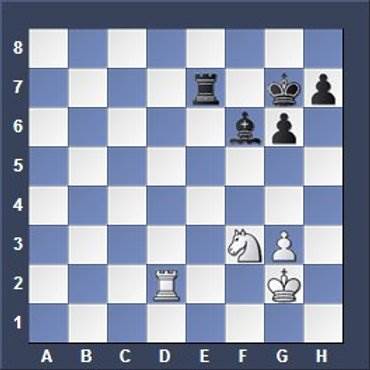
R-Rook, N-Knight, B-Bishop, Q-Queen, K-King
For pawns just use coordinates ONLY
Click below to see contributions from other visitors to this page…
Pawns and weak squares are my ruination.
The Winner!
 Sick of Losing at Chess? Get Chess Courses from a Grandmaster! HUGE Discount! Click here!
Sick of Losing at Chess? Get Chess Courses from a Grandmaster! HUGE Discount! Click here!Get Chess Course -Beginners Package- from a Grandmaster! Huge Discount!
Privacy Policy Impressum/Disclosure Disclaimer Donate
© 2008- www.Expert-Chess-Strategies.com
